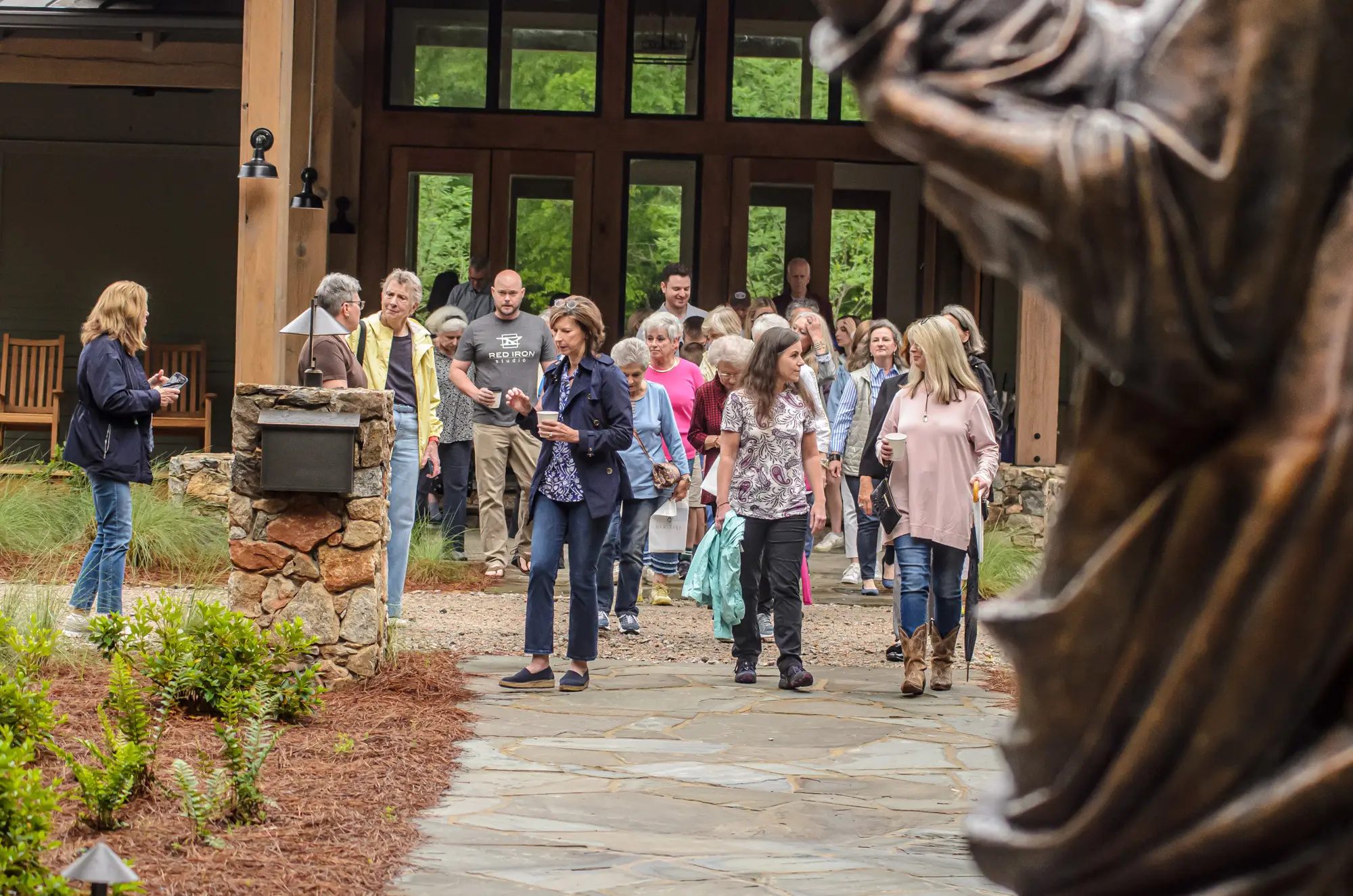A brief history of the devotion, The Way of the Light (Via Lucis)
In the 1990s, Father Sabino Palumbieri, a Salesian priest in Rome, developed the idea for the Stations of the Resurrection, or the Way of the Light, as a complimentary devotion to the Stations of the Cross, or the Way of the Cross. The latter can find its origins as early as the 4th century, when pilgrims from all over the world came to Jerusalem to visit the scenes of Christ’s passion, and today nearly all Catholic churches display images of the devotion.
Since 1883, the Church of the Purification of the Blessed Virgin Mary, just down the road from Heritage, has held its own display of the Stations of the Cross.
While the Way of the Cross follows Christ’s passion, death, and burial and illustrates events of great sorrow, the Stations of the Resurrection takes the faithful through the most joyful and glorious of the mysteries of Christ, which the Catholic Church celebrates for fifty days out of the liturgical calendar. It offers prayerful reflections on each appearance of the Risen Lord and different scenes leading up to the descent of the Holy Spirit to bring about faithful hope, peaceful consolation, and joyful celebration in the hearts of all Christians.
The stations in Resurrection Meadow
Constructed on about five acres of the Heritage property, Resurrection Meadow is its newest stations prayer space, similar to Grace Garden and the Seven Sorrows Walk, with a circular walking trail that takes guests through each moment of significance for the disciples during the time of the Resurrected Christ.
At the entrance of Resurrection Meadow, guests pass by a striking natural rock formation which can remind them of Christ’s empty tomb discovered by the disciples after the Resurrection (2nd station). A large, circular space sits at the start and end of the walking trail and features on the ground a stone Celtic Knot design, which originated in Ireland. Its three points represent the Holy Trinity, and the second one directs the eye straight ahead to a life-sized, stained glass art display of the Risen Lord, which can be seen from every station.
Each station displays the scenes in stained glass, from the resurrection itself (1st station) to the descent of the Holy Spirit (14th station), all designed by the same artist. Along with the images, the stations feature engravings of scripture passages in their entirety, while Grace Garden only features scripture references for each joyful mystery of the rosary.
The art of the stations utilizes a consistent color palette of red, yellow, and orange for some and blue, green, and yellow for the others. The careful and intentional use of coloring draws the viewer’s attention toward different figures in a remarkable way.
A part of the design worth noting: the stations are fashioned in groups of two or three, excepting Christ’s interaction with St. Thomas (8th station) and Pentecost (14th station).
The small pavilions included in the meadow, each accompanied by a seating and table arrangement (chairs, benches, coffee tables, dining tables, etc.), provide shade and relief from the heat during the warmer months. These gathering spaces make a perfect small-group setting for retreatants and rest stop for groups or individuals of every kind. As guests gather together in these spaces, they may place themselves in the shoes of the disciples who, with Mary, gathered together in anticipation of the coming of the Holy Spirit (13th station).
Situated at its lower end, the sloping meadow prominently features an outdoor amphitheater with an eastward-facing altar. It is accessible for guests from the grass pathway between the 7th and 8th stations. The venue has a variety of uses, and it is the perfect location for a sunrise Mass during the Easter season, when the faithful are encouraged to intentionally and prayerfully enter into the mystery of the Resurrection.
First Station: Jesus Rises from the Dead
The angel said to the women, “Do not be afraid; for I know that you seek Jesus who was crucified. He is not here; for he has risen as He said.” (Matthew 28:5-6a)
The scene of the first station illustrates something that the women to whom the angel was speaking did not directly witness: the Risen Lord Jesus, body and soul, in the fulfillment of the many promises of God and a most triumphant victory over sin and death, leaving behind the tomb made by human hands.

Second Station: The Disciples Find the Empty Tomb
Peter rose and ran to the tomb; stooping and looking in, he saw the linen cloths by themselves. (Luke 24:12)
The scene of the second station shows Peter alone in the tomb picking up and examining the burial cloths of Jesus. The empty tomb is a silent witness to the most glorious and joyful event of the Christian faith. Here, we may mediate on the empty tombs of our own lives; the coldest and loneliness places are precisely where Jesus seeks to encounter His disciples.
Third Station: Jesus Appears to Mary Magdelene
The Disciples Find the Empty Tomb. Peter rose and ran to the tomb; stooping and looking in, he saw the linen cloths by themselves. (Luke 24:12)
The scene of the second station shows Peter alone in the tomb picking up and examining the burial cloths of Jesus. The empty tomb is a silent witness to the most glorious and joyful event of the Christian faith. Here, we may mediate on the empty tombs of our own lives; the coldest and loneliness places are precisely where Jesus seeks to encounter His disciples.




